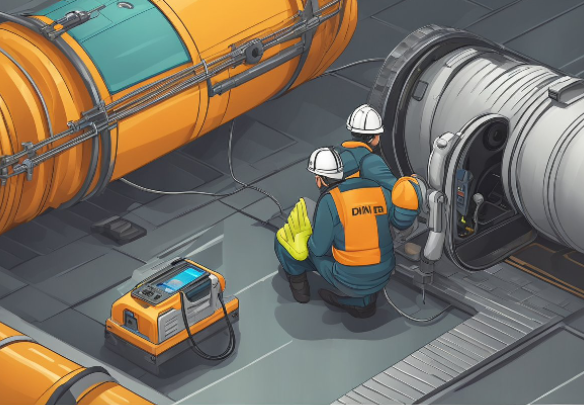Drain inspection cameras have become an essential tool for plumbing professionals and homeowners alike. These cameras allow experts to inspect the inside of pipes and identify any issues that may be causing blockages or other problems. By using a drain inspection camera, a plumbing expert can quickly and accurately diagnose the issue and take the necessary steps to fix it.
One of the key benefits of using a drain inspection camera is that it allows experts to see inside pipes without having to remove them. This means that the inspection process is much less invasive, and it can be completed much more quickly. Additionally, the camera can capture high-quality images and video footage of the inside of the pipe, which can be used to identify any issues that may be present.
If you are experiencing issues with your plumbing system, it may be time to call in a drain expert who can utilize a drain inspection camera to identify the problem. By doing so, you can save time and money, as well as avoid the need for more invasive repairs down the line. Whether you are a homeowner or a plumbing professional, a drain inspection camera is a valuable tool that can help you keep your plumbing system in top condition.
Understanding Drain Inspection Cameras
Drain inspection cameras are an essential tool for drain experts, plumbers, and contractors who need to inspect the condition of pipes and drains. These cameras are designed to provide a clear view of the inside of pipes, allowing professionals to identify any damage, blockages, or other issues that may require repair.
Types of Drain Inspection Cameras
There are two main types of drain inspection cameras: push cameras and robotic cameras. Push cameras are handheld devices that are pushed through the pipe manually, while robotic cameras are self-propelled and can move through the pipe autonomously.
Push cameras are typically smaller and more portable than robotic cameras, making them ideal for smaller pipes and tight spaces. Robotic cameras, on the other hand, are larger and more powerful, making them better suited for larger pipes and more complex inspections.
Key Features and Specifications
When choosing a drain inspection camera, there are several key features and specifications to consider. These include the camera resolution, cable length, and lighting options.
Camera resolution is an important factor as it determines the clarity and detail of the images captured by the camera. Cable length is also important, as it determines how far into the pipe the camera can reach. Lighting options are also important, as they determine how well the camera can illuminate the inside of the pipe.
Advantages of Using Inspection Cameras
Using a drain inspection camera has several advantages over traditional methods of pipe inspection. First, it allows professionals to identify issues quickly and accurately, reducing the need for costly and time-consuming excavation. Second, it allows professionals to diagnose issues more accurately, leading to more effective repairs and better long-term outcomes. Finally, it allows professionals to provide visual evidence of the condition of the pipes, which can be useful for insurance claims and legal disputes.
Overall, drain inspection cameras are an essential tool for anyone working in the plumbing or drain industry. By providing a clear view of the inside of pipes, they allow professionals to diagnose issues quickly and accurately, leading to more effective repairs and better long-term outcomes.
Becoming a Drain Expert
Becoming a drain expert requires a combination of technical knowledge, practical experience, and problem-solving skills. Drain experts are responsible for inspecting, diagnosing, and repairing drainage systems in residential, commercial, and industrial settings.
Essential Skills for Drain Experts
Drain experts must have a solid understanding of plumbing systems, including the principles of gravity, pressure, and flow. They should be familiar with different types of pipes, fittings, and fixtures, as well as the tools and equipment used in drain inspection and repair.
In addition to technical knowledge, drain experts should have excellent communication skills to interact with clients, colleagues, and other stakeholders. They should be able to explain complex issues in simple terms and provide clear recommendations for repairs or replacements.
Best Practices for Drain Inspection
When inspecting drains, experts should follow best practices to ensure accurate diagnosis and efficient repair. They should start by gathering information about the drainage system, including its age, history, and any previous repairs or replacements.
During inspection, drain experts should use high-quality cameras and other tools to capture clear images and videos of the pipes and other components. They should also be able to identify common issues such as blockages, leaks, corrosion, and damage.
Based on their findings, drain experts should develop a comprehensive repair plan that addresses the root cause of the problem and minimizes disruption to the client. They should also provide clear cost estimates and timelines for the repair work.
Common Challenges and Solutions
Drain experts face a range of challenges in their work, from dealing with difficult clients to navigating complex drainage systems. Some common challenges include:
- Blockages caused by hair, grease, food waste, and other debris
- Corrosion and wear and tear on pipes and fittings
- Tree roots and other vegetation infiltrating pipes
- Poor installation or maintenance of drainage systems
To overcome these challenges, drain experts should stay up-to-date with the latest technologies and techniques in drain inspection and repair. They should also be able to think creatively and adapt to changing situations as needed.
Overall, becoming a drain expert requires a combination of technical knowledge, practical experience, and problem-solving skills. With the right training and experience, anyone can become a skilled and reliable drain expert.

